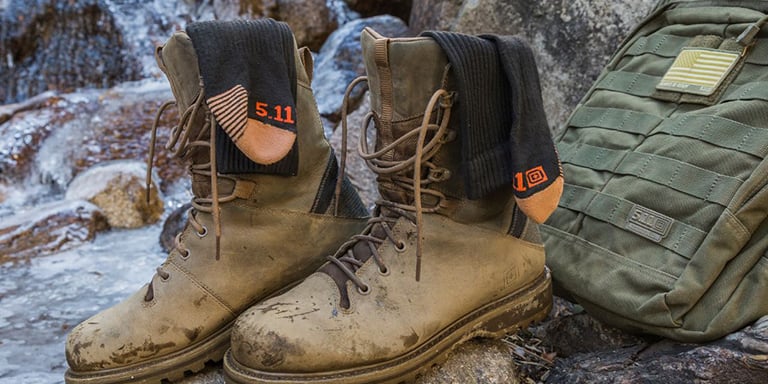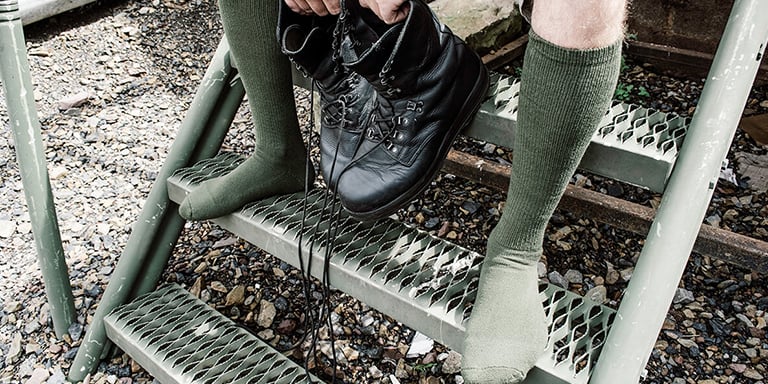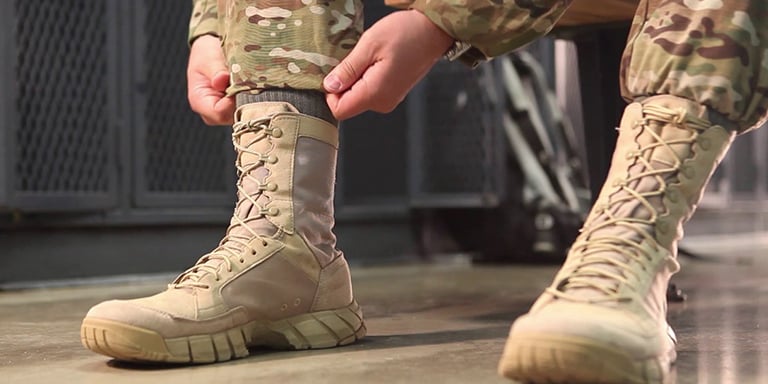How to choose military and tactical socks?

Military and public service jobs are often very hard on your feet. Without proper footwear, painful blisters on the toes and heels can be downright debilitating. Although find the right pair of police shoes Or choosing the right military rangers usually receives the most attention, the choice of socks is just as important. Blisters are caused by friction and heat on the skin, so the socks you choose will be your first line of defense.
Understanding sock materials

There's a lot to consider when choosing socks, but by far the most important factor is the material they're made from. The human foot is one of the sweatiest places in the body. All that moisture can lead to blisters, cracked or chafed skin, fungal infections, and smelling pretty ripe.
If you grew up with standard cotton tube socks, you'll be pleasantly surprised to learn that modern sock technology (materials) can often eliminate (or at least help manage) all of these problems.
Cotton socks
Cotton is the most common material used in the production of socks because it is both inexpensive and comfortable for leisure activities. However, cotton socks are not suitable as sportswear. Once you start sweating in cotton socks, you'll find that they get saturated quickly and take a long time to dry. This phenomenon is often so severe that you can end up with maceration, also called "pruning" of your feet. Cotton's inability to wick moisture away from the foot makes it the most common culprit among those complaining of blisters, regardless of the footwear worn.
Synthetic socks
Synthetic socks are specifically designed for sportswear and marketed under names such as "sport", "performance" or "athletic". They are usually a mix of many materials, combined to create a more durable sock. Common synthetic materials include nylon, lycra, polyester, and polypropylene. Nylon and lycra are stretchy and durable. Polyester and polypropylene are lightweight, quick-drying and moisture-wicking.
The moisture-wicking and quick-drying properties of synthetic socks compared to cotton cannot be overstated. This does not mean that they cannot be saturated with sufficient activity. But even then, they dry out quickly if removed and exposed to the sun.
Unfortunately, synthetic materials tend to develop a stink, especially after more than a day. This can vary from person to person, but it's a distinct downside when you can't carry extra pairs.
Wool socks
If you want to avoid the stink that often accompanies synthetic socks, merino wool is a magic fiber. The difference in the bad smell department is really noticeable. They regulate temperature and wick away moisture, so your feet stay comfortable in a wide range of conditions. Unlike the rough wool of previous generations, modern wool socks are made from merino wool and are generally itch-free. You will find, however, that wool socks are more expensive than their synthetic counterparts. They also require a separate, more delicate detergent and wash cycle for longevity.
Wear under socks
Liner socks are thin socks that are usually worn with a heavier outer sock. This two-sock system works by wicking moisture from the inner layer through to the second outer layer of the sock. Although this is a popular technique for preventing blisters, it is not necessarily a foolproof solution. Ultimately, having your shoes and socks fit properly is the most important factor in preventing blisters.
Sock thickness and padding

The thickness of the socks you choose is influenced by many factors. More cushioning and padding is needed if you are carrying heavy loads. However, this thickness will provide additional insulation and warmth which may not be desired. It is important that your feet do not slip inside your boots or shoes. Any difference in volume between your feet and your boots can be compensated by the correct sock thickness. Always try on the shoes with the socks you intend to wear to make sure they fit properly. Socks are generally sold under the names of liner, light weight, medium weight and heavy weight.
-
Under-socks are usually worn as a thin base layer that wicks away moisture.
-
Light socks are ideal for hot weather.
-
Socks mid-weight balance comfort for hot and cool conditions.
-
thick socks provide the most cushioning and warmth.
Sock height

The height of the shoes you wear and department regulations are common reasons for choosing a particular sock fit. For sportswear, you generally want the sock to extend beyond the top of your boots or shoes to avoid chafing or chafing on bare skin. Sometimes it comes down to personal style. Although they are marketed under many names, the four cuts below are the main options.
-
The ankle socks are placed just below or at the height of the ankle.
-
Quarter socks have full ankle coverage.
-
Mid-Crew socks sit below calf height.
-
Socks mid-calf usually rest at mid-calf.
Tips for choosing the right socks

Avoid cotton
Although cotton works well for leisure activities, you should avoid it for sportswear. The improved performance of synthetic or merino socks is well worth the extra cost. You will find that we offer little or no cotton socks on this site for this reason.
Prioritize the right fit
Not all sock brands are the same when it comes to sizing. To determine the correct fit, make sure the heel of the sock fits exactly where it's supposed to. There should be no additional material in the toe or heel area. The extra material can bunch together and chafe, causing blisters. The same goes for socks that are too small - they can slip off and cause rubbing blisters.
Think about your shoes
Choosing the right socks is highly dependent on the type of boots you wear. Get an idea of how your boots fit the socks you'll be wearing on the court. If you're between sizes, use thicker socks to fill the gap on slightly oversized boots. You can also consider thinner socks when your boots are too tight. The most important factor in preventing blisters is that all of your shoes fit properly, including socks.
As everyone has different feet, choosing the right shoes and socks is a personal decision. What works well for someone else may not work for others. Start by prioritizing the right fit and choosing materials suitable for the conditions you'll encounter most often. With the perfect pair of socks, you're sure to be comfortable, dry and blister-free.
0 comments
